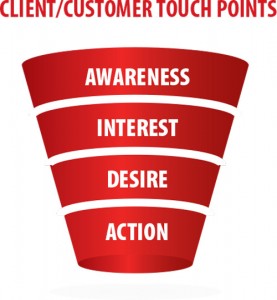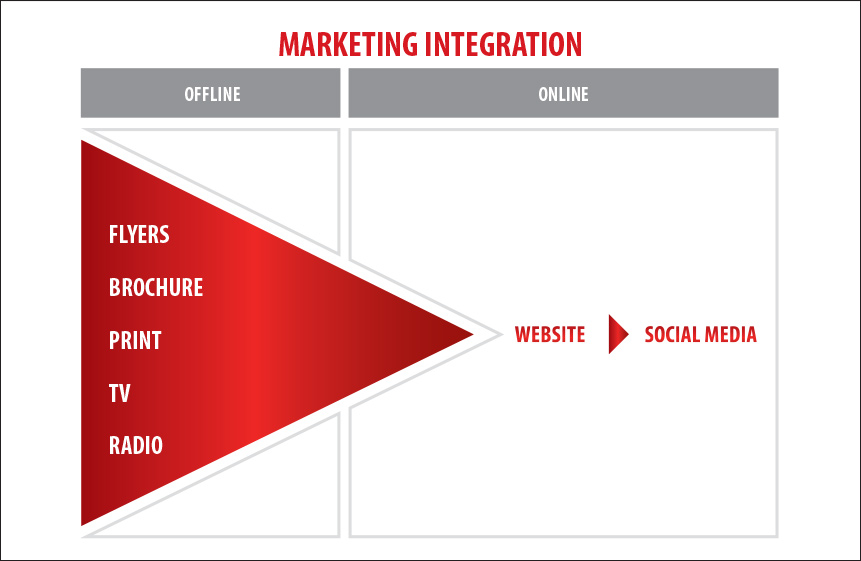Six Tips for Integrating your Traditional Marketing Efforts with your Online Marketing Efforts

According to PEW Internet, two-thirds of online search queries are driven by offline advertising. Clearly, without strong integration, you risk not meeting and fulfilling your customer’s needs, which can negatively affect their experience with your organisation, or worse, drive them to a competitor.
Have you heard of R.O.P.O; Research Online, Purchase Offline or visa versa Research Offline and Purchase Online. Search is key to the research online, purchase offline effect (ROPO) with search playing a pivotal role in pre-purchase research and opinion forming.
When considering search and online integration, it’s essential to factor in search’s ability to drive offline sales, not just online. Search response extends beyond online to offline channels.
In 2011, a consumer study by consultancy Accenture hinted at the prevalence of ROPO (research online, purchase offline). It found that, in the EU, 69% of consumers research product features online, while 68% compare prices online before shopping in a physical store and 58% locate items online before going to a store to purchase (Accenture 2011)
Understanding search’s role at each step on the path-to-purchase, and the way other traditional media affects search behaviour will help maximise integration.
Here are 6 tips to integrate your online and offline marketing efforts to ensure a strong brand experience for your customers/clients
1. Determine your Goals both Online and Offline
If your company executes a lot of different marketing/promotional tactics, chances are you have an overall marketing strategy and goal already worked out. If you don’t have this, take a step back and map out what you’re really trying to do. Let’s say your goal is to create more brand awareness among senior engineers within the medical devices industry. That means every effort should be focused on reaching a targeted audience and simply sharing your brand information and benefits. In that case you would have a different marketing mix that someone who wanted to generate leads from a managing director of medical devices company.
From there, think about how this overall marketing goal translates to your website and your online efforts. If your overall goal is to generate high quality leads, is your online goal then to capture contact information so you can potentially meet the lead in person? Or is it contact information to then follow up and ask if they want a trial. Also think about how you are going to measure success for what you are trying to do. Go beyond just rankings and think about other metrics – time on site, bounce rates, cost per visit, etc.
2. Before you do any more for SEO, map out all of your marketing efforts
List out everything you are currently doing, both online and offline to help get your brand noticed. This could include (but certainly not limited) to: public relations, social media, collateral development, dealer incentive programs, radio, trade shows, promotions, contests, etc. Put this all down on paper so you can later establish the connection to your website.
3. Map out efforts and link them to the online space
Think about everything you are doing at the moment with your marketing efforts, in one way or another a lot of what you are doing is driving traffic to your website. For instance, if you have a lot of collateral materials, do you put a PDF version (or the content itself) onto your website? If so, you should be thinking about this connection when you write the copy for the brochure. If you aren’t putting your brochures onto your site, why not? This can be a good way to add additional content onto your site.
As you get your site optimised, start working your SEO best practices into all of your other efforts as well. Is it time to write and print a new brochure? Give the person writing, a list of your keywords and highlight the top 5-10 most important ones that apply to that brochure.
For press releases, do the same thing. Give your PR team your keywords but then also scan the release before it goes out to make sure it is optimised for SEO success. Also, be sure you always include a link back to your site within the release, so if it is picked up, you could also help out your link building at the same time. The important aspect to remember about your offline marketing is where it could end up online and what can you do to ensure that it is optimised for success.
4. Integrate your offline promotion with your online presence
Prominently feature your offline promoted products on your website. Ensure that the top promoted products or services on your fliers, print, TV and radio efforts are also found above the fold on the home page or category landing pages of your site so your customers/cli
ents can easily find them. To the extent possible, ensure that the prices and offers promoted in your advertising match the prices on your website.
For extraordinary or annual promotions, build out search optimised content for the product related targeted keyword phrases to build search engine visibility (this should be done months in advance). By helping your customer easily find the product or services they are looking for on your website, you are creating a better experience for their interaction with your site and brand. Doing so also eliminates roadblocks to their ease of converting on your site.
5. Amplify your message through social media marketing to create a buzz for your off-line promoted products
To start, incorporate the language you use in your off-line and paid search efforts into your social marketing initiatives. Seek out bloggers, thought leaders, LinkedIn groups and tweets about the same or similar products/services to join in the social conversations about the products/services you’re promoting. Use targeted keywords in your social media marketing postings to increase the potential of the social content appearing in the organic search results.
Also, don’t forget to include links to the promoted product landing pages to drive traffic to your site as well. By promoting your products/services throughout social media marketing websites i.e. LinkedIn, Facebook, Twitter etc, you are increasing the frequency at which your potential customers/clients associate your organisation with the products they are looking for.
6. Use real time search data to promote the products your customers/clients are looking for the most
Identify which products and services are in highest demand based on search query volume available from the search engines. Then use search engine keyword trend data to identify keywords that are increasing in popularity, for this try out Google Trends or Twitter. You can also use search engine geo-specific search volume data to identify regional search trends.
Overall, integrating your offline and online marketing efforts enables you to strengthen your brand by ensuring that you are there when your customers/clients are looking for you. Doing so will allow you to fulfil their needs and increase the likelihood that they will come back again.
Once you have identified the combination of keyword and ad creative that drives the most qualified traffic to your website, you should incorporate that language into your offline marketing. By speaking to your customers/clients with the language that resonates with them the best, you are fostering a connection between the customer and your brand, reinforcing that you are the best provider of the products they are looking for.
Matching the right message with the right media is important. Utilising different messages for different touch points would be essential.
For further details, please contact us on 091 739450 or email [email protected]

